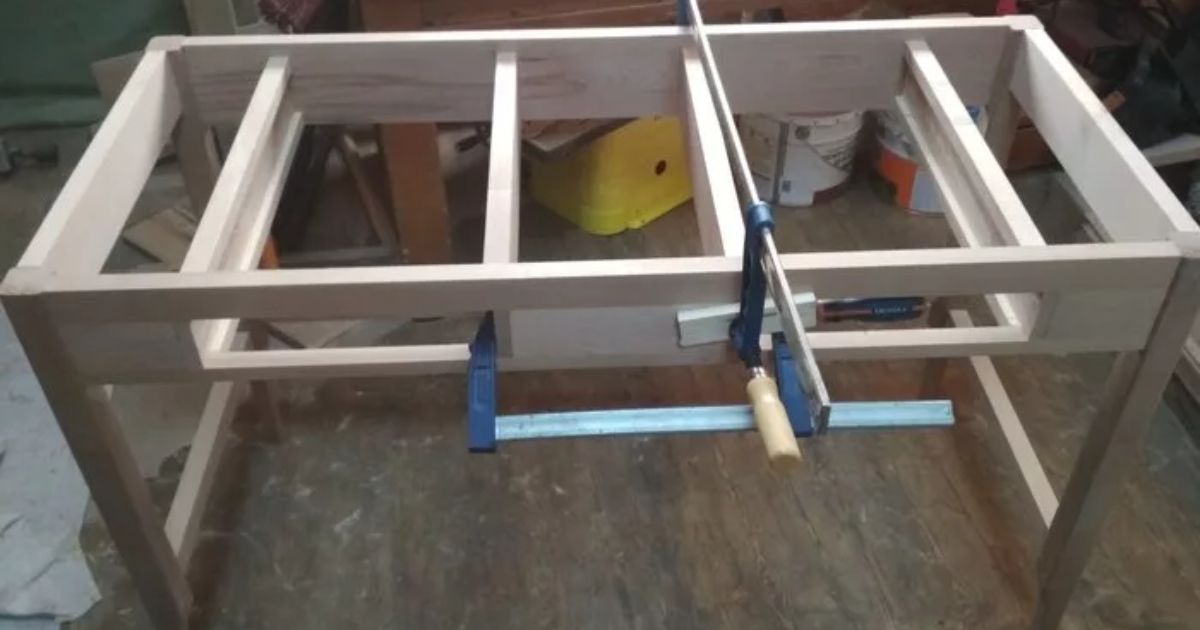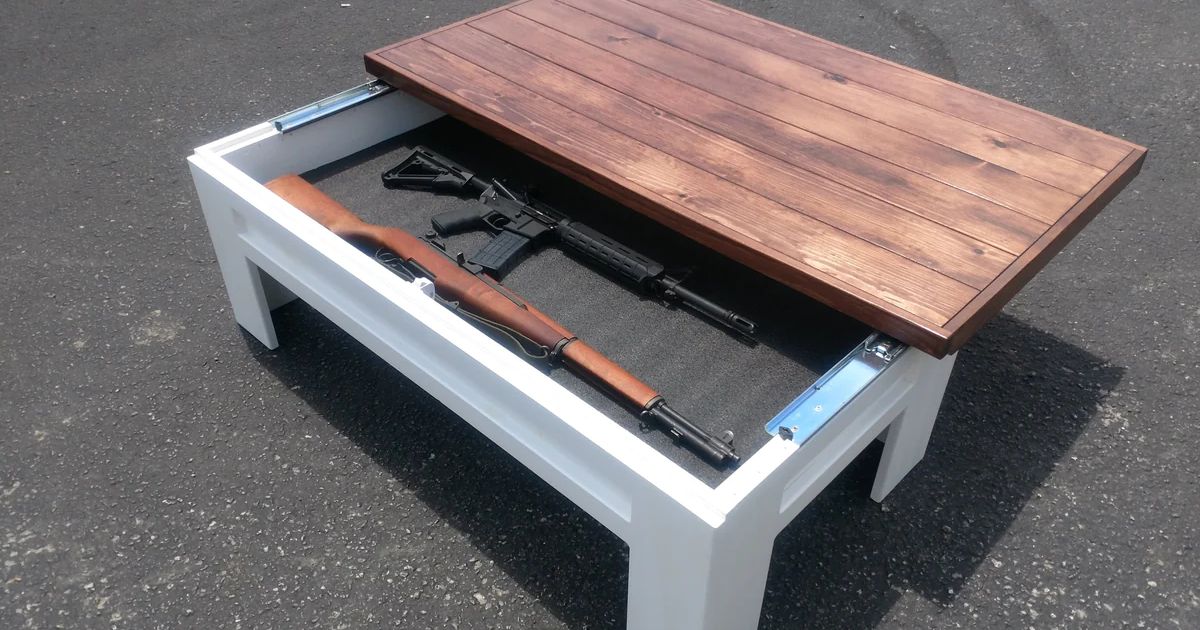Are you looking to add a touch of functionality and style to your living space? Look no further than our comprehensive guide on how to build a sliding top coffee table.
This article will provide you with step-by-step instructions, detailed diagrams, and expert tips to help you create a stunning piece of furniture that not only serves as a coffee table but also offers hidden storage compartments.
Join us as we embark on this creative journey and transform your living room into a space that exudes elegance and practicality.
Key Takeaways
- The materials and tools needed for building a sliding top coffee table include a sturdy wooden base, sliding mechanism, screws, nails, wood glue, sandpaper, power drill, saw, clamps, tape measure, pencil, level, plywood, and sliding hardware.
- The process of building the table involves measuring and cutting wooden boards for the frame, assembling the frame, creating the top support and base, constructing the sliding top, and adding storage compartments.
- Finishing touches include sanding, applying a protective finish, and allowing it to dry completely.
- The sliding top coffee table offers functionality and versatility, with the ability to transform into a mini entertainment center and adjust the height and position of the table.
Materials and Tools Needed
The construction of a sliding top coffee table requires a comprehensive list of materials and tools.
To begin with, you will need a sturdy wooden base, preferably made from solid oak or pine, to ensure durability and strength.
You will need a sliding mechanism, such as drawer slides or roller slides, to enable smooth and effortless movement of the table top.
Other essential materials include screws, nails, wood glue, and sandpaper for assembly and finishing touches.
As for tools, you will require a power drill, a miter saw or circular saw for cutting the wood, and various woodworking clamps to hold pieces in place during assembly.
A tape measure, pencil, and level will also come in handy to ensure accurate measurements and alignment.
With these materials and tools at hand, you will be well-equipped to embark on your journey of building a beautiful and functional sliding top coffee table.
Building the Table Frame

Constructing the table frame involves carefully measuring and cutting the wooden boards to create the desired dimensions and shape. The frame provides the structure and stability for the sliding top coffee table.
To begin, gather the necessary wooden boards and cut them according to the measurements specified in the plans. Use a saw to make precise cuts, ensuring that the boards fit together seamlessly. Once the boards are cut, assemble the frame by joining the pieces using screws or nails. Make sure to align the corners and edges properly for a sturdy frame. Pay attention to detail, ensuring that the frame is square and level.
With the table frame complete, it’s now time to move on to creating the top support and base, which will provide further support and functionality for the sliding mechanism.
Creating the Top Support and Base
An effective way to create the top support and base for the sliding top coffee table is by carefully selecting and attaching the appropriate hardware and components.
To build a small outdoor coffee table, the top support is crucial as it provides stability and ensures smooth movement of the sliding top. It is recommended to use heavy-duty drawer slides for this purpose, as they can handle the weight of the top while allowing it to slide effortlessly. These slides should be securely attached to the table frame using screws or bolts.
It is important to consider the base of the coffee table. It should be sturdy enough to support the weight of the table and its contents. Using solid wood or metal for the base will provide the necessary strength and durability.
Constructing the Sliding Top
Carefully measuring and precisely cutting the wooden panels is essential for creating a flawlessly smooth sliding top for the coffee table.
To begin constructing the sliding top, gather the necessary materials, including the wooden panels, hinges, and screws.
Start by measuring the dimensions of the coffee table frame to ensure that the panels fit perfectly. Using a saw, cut the wooden panels according to the measurements, ensuring clean and accurate cuts.
Next, attach the hinges to the underside of the panels, making sure they are properly aligned for smooth movement. Secure the hinges with screws, ensuring they are tightly fastened.
Finally, attach the sliding top to the coffee table frame, making sure it glides effortlessly. Check for any adjustments needed to ensure a seamless sliding motion.
With attention to detail and precision, the sliding top will add functionality and style to your coffee table, creating a sense of belonging in your living space.
Adding Storage Compartments

To build a coffee table with storage, designing and incorporating storage compartments into the coffee table allows for convenient organization and easy access to items such as books, magazines, or remote controls. By adding these compartments, you can keep your living space clutter-free and create a sense of belonging by having everything in its place.
One way to incorporate storage compartments is by dividing the inside space of the coffee table into sections. You can use dividers or create separate compartments with varying sizes to accommodate different items.
Another option is to incorporate drawers or sliding trays, which provide hidden storage and keep the tabletop clean and uncluttered. Here is an example of how you can divide the inside space of the coffee table:
| Compartment 1 | Compartment 2 | Compartment 3 |
|---|---|---|
| Books | Magazines | Remote Controls |
Once the storage compartments are in place, it’s time to move on to the finishing touches and sanding, which will be discussed in the next section.
Finishing Touches and Sanding
After the storage compartments have been added, it is important to carefully apply the finishing touches and sand the coffee table to ensure a smooth and polished final product. This step is crucial in achieving a professional and high-quality appearance. Here are three key steps to consider:
- Sanding: Start by using coarse-grit sandpaper to remove any rough edges or imperfections. Gradually move to finer-grit sandpaper to achieve a smooth surface. Be sure to sand in the direction of the wood grain to avoid scratches.
- Filling cracks and gaps: Use wood filler to fill in any cracks or gaps in the table. This will create a seamless surface and enhance the overall aesthetics.
- Staining or painting: Choose a stain or paint that complements your décor. Apply multiple coats, allowing each coat to dry completely before adding the next.
Applying a Protective Finish
Before moving on to the final step of the coffee table construction process, it is essential to understand the importance of applying a protective finish to ensure long-lasting durability and preserve the table’s aesthetics.
A protective finish acts as a shield against scratches, spills, and general wear and tear, prolonging the life of your coffee table. It also enhances the natural beauty of the wood, giving it a rich and polished appearance.
To apply the protective finish, start by lightly sanding the surface to create a smooth canvas for the finish. Then, using a brush or a cloth, evenly apply the finish in long, even strokes, following the grain of the wood. Allow it to dry completely before moving on to the next step of enjoying your sliding top coffee table.
Enjoying Your Sliding Top Coffee Table

To fully appreciate the functionality and versatility of your sliding top coffee table, take the time to explore its various features and discover the endless possibilities it offers for organizing and enhancing your living space.
Here are three ways you can enjoy your sliding top coffee table:
- Organization: Utilize the multiple compartments and hidden storage spaces to keep your living room neat and tidy. Store magazines, remote controls, and other items you want to keep within reach but out of sight.
- Entertainment: Transform your coffee table into a mini entertainment center. Slide open the top to reveal a built-in media console where you can place your TV, gaming console, or sound system. Enjoy movie nights or gaming sessions with friends and family, all conveniently within arm’s reach.
- Flexibility: The sliding top feature allows you to easily adjust the height and position of your coffee table. Use it as a dining table for casual meals or as a workspace for your laptop. The possibilities are endless, providing you with the flexibility to adapt to different needs and occasions.
With its innovative design and practical features, your sliding top coffee table is sure to become a focal point of your living space, offering both style and functionality.
Frequently Asked Questions
How Much Weight Can the Sliding Top Coffee Table Support?
The weight capacity of a sliding top coffee table depends on various factors such as the materials used, construction techniques, and design. It is essential to consider these factors to ensure the table can support the desired weight without compromising its functionality or structural integrity.
Can I Use Different Types of Wood for the Table Frame?
When considering the construction of a sliding top coffee table, it is important to address the question of whether different types of wood can be used for the table frame. This allows for customization and flexibility in design choices.
Are There Any Measurements or Dimensions Provided for the Storage Compartments?
When considering the measurements or dimensions for the storage compartments, it is important to take into account the overall design and functionality of the sliding top coffee table. Careful planning and precise measurements will ensure a successful build.
Can I Add Wheels to the Coffee Table for Easy Mobility?
Adding wheels to a coffee table can enhance its mobility, allowing for easy repositioning and convenience. Wheels should be strategically placed to maintain stability and balance. Consider the table’s weight and size when selecting appropriate wheels.
What Type of Protective Finish Is Recommended for the Table?
For a sliding top coffee table, it is recommended to use a protective finish that is durable and resistant to stains and scratches. Options such as polyurethane, lacquer, or epoxy can provide the necessary protection while enhancing the table’s appearance.
Conclusion
With the completion of your sliding top coffee table, you have not only crafted a functional piece of furniture, but also a conversation starter.
The ingenious sliding mechanism adds a touch of sophistication to your living space, while the storage compartments provide a practical solution for clutter.
By following the detailed instructions and applying a protective finish, you can ensure the longevity of your creation.
Sit back, relax, and enjoy the convenience and beauty of your one-of-a-kind coffee table.








